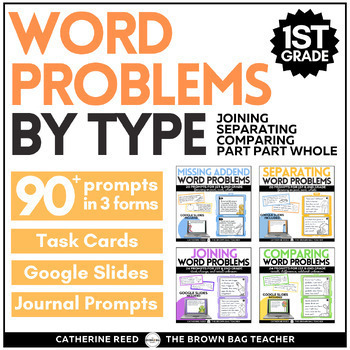1st Grade Word Problems by Type BUNDLE: Joining, Separating, Comparing
- Zip
- Google Apps™

What educators are saying
Products in this Bundle (4)
Description
Word problems (addition, subtraction, comparing, and part part whole) are essential for students as they foster critical thinking, problem-solving skills, and a deep understanding of mathematical concepts. Real-world scenarios, word problems make learning practical and relevant.
- Students learn to analyze, interpret, and apply mathematical principles, preparing them for both academic success and real-life challenges.
- Problem-solving also cultivates resilience, adaptability, and effective communication skills, contributing to a well-rounded education.
This year-long word-problem-by-type bundle empowers students with the skills needed for academic and lifelong success.
INCLUDED IN THIS RESOURCE
90+ WORD PROBLEMS (Addition, Subtraction, Comparing, Missing Addends)
- Start Unknown
- Change Unknown
- Result Unknown
OFFERED IN 3 FORMATS
- Task Cards (black and white)
- Math Journal Prompts (black and white)
- Google Slides (color)
USING THIS RESOURCE
Use these ready-to-print or display word problems as...
- Task Cards
- Small-Group Tools
- Independent Practice
- Math Journal Prompts
✅Download the preview to get a closer look at these templates and examples from my classroom!
___________________________________
Having difficulty with a file?
Visit the FAQs section, submit a help ticket, or ask a question on the Q& A tab before leaving feedback.
___________________________________
Copyright © Catherine Reed, The Brown Bag Teacher
Permission to copy for single classroom use only.
Please purchase additional licenses if you intend to share this resource.





